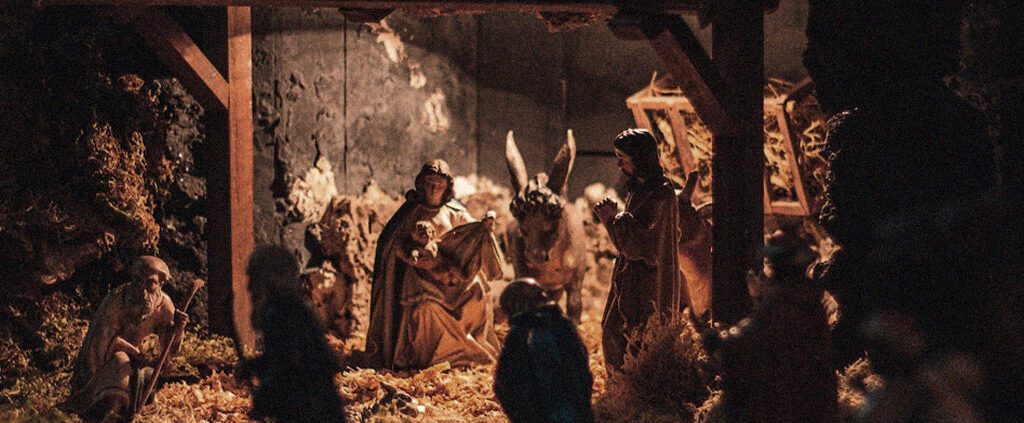Appreciating the Christmas Story through Fresh Eyes
When I was five, I went through a stage where I refused to be called by my own name.
I was no longer Jessica. Instead, I was Mary. Why? Because I had this plastic baby doll whom I had named Jesus.
Fast forward more than two decades, here I am, a few days out from Christmas, heavily pregnant, definitely feeling pretty “Mary-like”!
With Christmas just around the corner, I’m sure all of us are seeing a lot of the nativity scene—the holy couple, tucked neatly into a triangular barn, with heads tilted toward the chubby babe Jesus, laid in a manger of hay. The barn stands remote from any other building, with a big star hanging right above. There are shepherds there too, with a handful of sheep, and three opulent wise men, with their fancy boxes and camels.
But did you know that a lot of how we picture the nativity scene may not be totally accurate?
Yes, there was the virgin mother, the Christ child, and there were some animals involved. However, the way we imagine it to be that calm and peaceful night isn’t quite accurate.
Firstly, the idea of the holy couple in some stable situated in the middle of nowhere, after having faced a series of stern-faced inn keepers who shook their heads and hustled them along until one was merciful enough to offer a barn. Secondly, that Mary somehow very serenely popped Jesus out, a plump picturesque baby, without any labour pains in the picture.
Given how Christmas has turned out to be this huge “holiday”, it’s easy to see why we hold onto this romantic picture of Jesus’s birth. But if we were to read the Christmas story in its original context, we’d come to see how it happened during a time of unrest and chaos—far from the idyllic nativity scene we like to imagine.
In the book, Jesus Through Middle Eastern Eyes, author Kenneth E. Bailey highlights some key misconceptions about the Christmas story, and I have listed three that I find worthwhile to take another look at this Christmas:
1. The holy couple were not turned away from the “inn”
According to Bailey, the word for “inn” in Luke 2:7 is not the same word that was used to describe a hotel room or other rented space (e.g., the room that the Good Samaritan paid for the beaten man to stay). Instead, “inn” here translates to “guest room”, which a typical house at that time would have as an extension. This meant that given the culture of that time, which placed a huge emphasis on hospitality, no self-respecting person would have denied accommodation to Joseph nor his expecting wife Mary.
The point Bailey makes here is, rather than imagining an inn keeper (and there’s no mention of that in the Scripture) denying them accommodation and pushing them into an “outhouse”, what we’re seeing is the holy couple arriving at a time when the guest space (the “inn”) of houses were already crammed with displaced guests and relatives because of the census-taking. So, the couple were likely given a space within the lower level of the house—which was considered part of the main house, not outside—where they would keep the animals only at night to keep them from getting taken.
Why might it be important for us to picture more accurately the setting of Jesus’s birth?
The busyness and chaos that surrounded Jesus’s birth could be a small reflection of how overwhelmed we can be in the lead-up to Christmas, as we prepare for our travels and gatherings. Beyond that, it might also tell us that, though we like to picture Christmas as a quiet and peaceful time, the first Christmas was a time when people were displaced, scrambling to find a place to stay while attempting to follow the orders of their fearsome rulers, all of which would’ve made the people unsettled and ill at ease.
And so, instead of feeling disappointed when this season doesn’t feel “peaceful”, we can take comfort in the fact that our Saviour knowingly came to us at a most unrestful time, because He is a God who willingly steps into our chaos to save us.
Rather than thinking that we need to have everything sorted out to welcome Jesus, we can be encouraged to receive Him even when things around us seem to be falling apart.
2. The manger was carved out of something hollow
Luke 2:7 tells us that Jesus, once born, was wrapped in swaddling clothes and laid in a manger. While some of us might picture the manger as a decent enough makeshift cradle covered with cloth, the actual manger was likely not a raised wooden box, but a carved-out hollow trough, shaped out of natural rock outcroppings, made with either clay blended with straw or stones set with mud. It would’ve been rough, dirty, and close to the ground, as it was where the animals ate out of.[1]
Seeing the manger for what it is reminds us of how humbling the circumstances were when Jesus was born, and that God had designated this lowly manger to be the very sign (Luke 2:12) that Jesus was the long-awaited Messiah. What a plot twist this would have been for those anticipating a grandiose arrival of the Saviour, for those expecting a battle-ready King to fight their wars—here He came, born as a weak baby to a lowly couple, completely unnoticed during a turbulent time, placed in the last spot anyone would think to look.
3. The shepherds were not a clean, cute bunch cuddled cosily together
Unlike the clean, cute, cuddly bunch depicted in children’s story books, shepherds were traditionally seen as social outsiders, considered “unclean” because of their work of tending to animals, hardly ever clean enough to worship with people in God’s presence.[2]
Yet they were the first to have heard of the birth of Jesus, and so received the privilege of telling everyone else the good news (Luke 2:8-20). From being outsiders who were always on the periphery, the shepherds were brought into the centre of the most important event of all time and gifted with the most amazing revelation and the most wonderful news.
And so, here’s another insight and comfort for us: Jesus came for everyone, regardless of our social status and power. He arrived in humble circumstances, so that the humbled and lowly, like the shepherds, could be welcomed into His presence and know Him and the joy and peace He brings.
For me, reflecting anew on the nativity and appreciating the story in its cultural context has not only been enlightening but encouraging. As I sit, breathlessly contemplating my infinite to-do list, the Christmas story is a hopeful reminder that regardless of what the next few days and weeks hold for me, Jesus is Emmanuel, God with me.
When the world feels cold, hostile, and hopeless, with the constant news of wars, rising cost of living, and the threat of losing our jobs, Isaiah 7:14 holds God’s ultimate promise of deliverance from this troubled world: “the Lord himself will give you a sign: The virgin will conceive and give birth to a son, and will call him Immanuel (meaning ‘God with us’)”.
God with us, not just in the tidy moments of our lives, but in the periods of stress, in the acute seasons of trial, amid the times when you feel inundated, overwhelmed, brought low, unworthy.
He stands with us in times of crisis. He weeps with us in those seasons of morning. And He celebrates with us, in times of triumph. He is a God of all seasons, who never leaves or forsakes us (Deuteronomy 31:6).
[1] Lisa Loraine Baker. “Was Jesus Really Born in a Manger?” Bible Study Tools.
[2] Bill Sytsma. “Unclean Shepherds.” Today Daily Devotional.














Leave a Reply
Want to join the discussion?Feel free to contribute!